有松絞りを再発見する寄り道。(愛知県名古屋市千種区 骨董買取・古美術風光舎名古屋店)
2021.04.23
こんにちは。スタッフYです。
今回は、先日の旧東海道の寄り道紀行の続編です。
鳴海~有松界隈のもう一つの寄り道ポイント、今回は、『有松絞り』です。
前回お伝えしましたとおり、鳴海宿の発展に欠かせない有松、鳴海絞り。

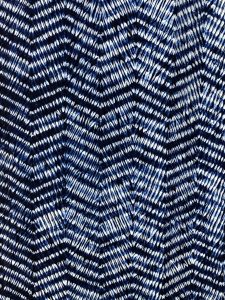
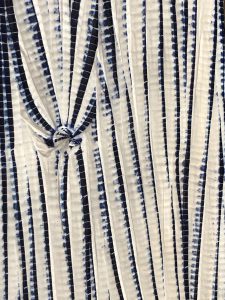
ここ有松は、1608年に東海道の保全のため徳川家尾張藩の布告による移住政策で作られた町であり、もともと耕地面積が少なく農業には向かない土地だったため、村人たちは、農業以外の収入源を求めていたそうです。そのような開拓者の1人であった竹田庄九郎が何か特産物を作らなければと考え出したのが有松絞りでした。
名古屋城を築城する際に訪れていた九州豊後の人々が着ていた絞り染めを見て手法を研究し考案し、はじめは手ぬぐいにして軒先に吊るして販売していましたが、やがて旅人が土産物として買うようになり街道一の名産品となったのが始まり。天和元年(1681)には、尾張藩第2代藩主徳川光友が第5代将軍徳川綱吉の将軍就任の祝賀として絞りを「九々利染」と称して献上したことから全国的に知られるようになったそうです。また、木綿の生産地である知多郡がそばにあり、流通の大きなパイプである東海道筋にあったため、資材や商品を運ぶ必要なくして商いできたことも大きいとも。有松・鳴海地方は参勤交代で江戸と行き来する西の諸大名たちの宿場でもあり、旅人が故郷への土産物としてこぞって絞りの手ぬぐいや浴衣などを買い求め、これが街道一の名産品となっていきます。その繁栄ぶりは、東海道五十三次などの浮世絵に描かれたほどですものね。
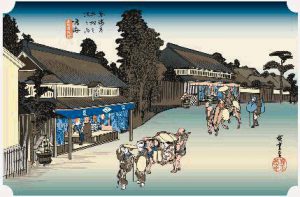
17世紀後半に浴衣が一般的に用いられるようになると、絞りの需要が拡大し、これに伴って、有松絞りの技術も発達していきます。。技術の発展に貢献したのは、2代目竹田庄九郎で、同氏は衣料としての絞り製品を開発。また、従来の藍染に加えて、紅染、紫染めなど染色技術も開発し、産業の基礎を築いきます。
有松絞りは現在に至るまでその後、幾度かの栄衰を繰り返します。明治時代に入ると全国で絞りの生産が盛んになりますが、一時的に有松での産業は衰退していきます。窮地を迎えますが、有松絞りの老舗である竹屋、橋本屋、井桁屋などが販売網の拡充や新たな技法の考案で復興させ再び全盛期を迎えます。改良開発の取り組みは精力的に行われ、1897年からの45年のあいだに、絞り染め技術の改良や新しい意匠の登録、特許取得を行い、独自の絞り染め産地としての地位は確固たるものにと、絞り技術そのものの存続維持にも努めていますね。
戦前は、地域を挙げての努力の甲斐あり、戦前の有松絞りの生産高は年間100〜120万反にもおよび、業況は隆盛しますが、やはり戦時中は徴兵・徴用にとられ、大部分の業者は転廃業に追い込まれていきます。戦後は生産が回復しすがが、工芸士の高齢化や技法や種類の減少に。
そして現在。有松絞りは新しい可能性に挑んでいます。有松絞りを新たなるファブリックのジャンルと捉えて全国、いえいえ世界に発信しているブランドもここ最近現れ、進化系有松絞りが登場しています。
パリの生地展示会ではエルメス、シャネル、ディオール、ロエベなど、そうそうたるラグジュアリーブランドから評価されたり、海外へ出店される有松発のデザイナーも。このパターン本当に多いですが、日本の伝統技術のすばらしさを海外の人から評価され再認識されるとは、我々あまりにも気づかなさすぎですよね笑。
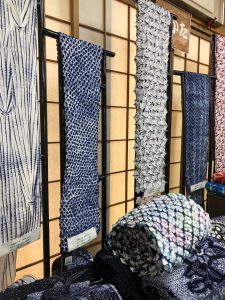
絞りは、「くくる」「ぬう」「たたむ」の単純な手作業の工程によりできた生地を、染め上げることで、布地に様々な模様を描き出す染色技法。江戸時代から考案された技はなんと100種類以上。複雑多岐にわたるため、独りの職人が一つの技法を極めます。これらの先人の遺産に支えられて引き継がれる絞りの技術や、手に取った時の良さを、たくさんに手にとって触れてみてほしいです。
そうそう、前日、都内某所にて、進化系絞りのバックを持った若い女性を発見。とりこみ方が本当におしゃれさんでした。これからの有松絞り、注目していきたいですね。
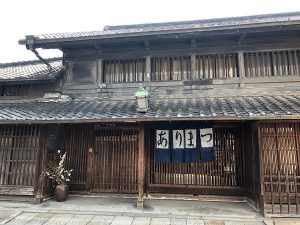
Hello. This is Staff Y.
The sequel to the detour trip of the old Tokaido the other day.
Another detour point in the Narumi-Arimatsu area. This time, it is “Arimatsu Shibori”.
As I mentioned last time, Arimatsu and Narumi Shibori are indispensable for the development of Narumi-juku.
Arimatsu is a town created in 1608 under the migration policy of the Tokugawa family Owari clan for the conservation of the Tokaido, and since the area of cultivated land was originally small and it was not suitable for agriculture, the villagers were not interested in agriculture. He was looking for a source of income. It was Arimatsu Shibori that one of those pioneers, Shokuro Takeda, thought that he had to make some special products.
Looking at the tie-dyeing worn by the people of Bungo, Kyushu, who visited when building Nagoya Castle, they researched and devised a method, and at first they made a towel and hung it on the eaves for sale, but eventually travelers bought it as a souvenir. It started to become the best specialty product on the highway. In the first year of Tenna (1681), Mitsutomo Tokugawa, the second feudal lord of the Owari clan, presented the iris nationwide as a celebration of the inauguration of the fifth shogun Tsunayoshi Tokugawa. It seems that it has become known. In addition, because Chita-gun, which is a production area of cotton, is nearby and it is located on the Tokaido line, which is a large distribution pipe, it is said that it was possible to do business without having to carry materials and goods. The Arimatsu / Narumi region is also a post station for various western daimyo who come and go to Edo on a change of attendance, and travelers buy squeezed towels and yukata as souvenirs to their hometown, and this will become the best specialty of the highway. .. Its prosperity is as depicted in Ukiyo-e such as the 53 Stations of the Tokaido.
hen yukata became popular in the latter half of the 17th century, the demand for squeezing increased, and along with this, the technology of Arimatsu squeezing also developed. .. It was Shokuro Takeda, the second generation, who contributed to the development of technology, and he developed squeezed products for clothing. In addition to the conventional indigo dyeing, we will also develop dyeing technologies such as red dyeing and purple dyeing to lay the foundation of the industry.
Arimatsu Shibori has continued to rise and fall several times since then. In the Meiji era, squeezing production became popular nationwide, but the industry in Arimatsu temporarily declined. Although we are facing a difficult situation, the well-established Arimatsu Shibori stores such as Takeya, Hashimotoya, and Igarashiya will reconstruct by expanding the sales network and devising new techniques, and will reach their heyday again. Efforts for improvement and development are vigorously carried out, and during the 45 years from 1897, we will improve the tie-dyeing technology, register new designs, obtain patents, and solidify our position as a unique tie-dyeing production area. ..
Before the war, it was worth the effort of the whole region, and the production of Arimatsu Shibori before the war reached 1 to 1.2 million a year, and the business situation was prosperous. Some of the contractors were forced to go out of business, and production recovered after the war, but due to the aging of craftsmen and the decrease in techniques and types.
And now. Arimatsu Shibori is challenging new possibilities. Arimatsu Shibori is regarded as a new fabric genre, and brands that are transmitting it nationwide, even to the world, have recently appeared, and the evolutionary Arimatsu Shibori has appeared.
At the fabric exhibition in Paris, there are designers from Arimatsu who are highly evaluated by such luxury brands such as Hermes, Chanel, Dior and Loewe, and who are opening stores overseas. This pattern is really common, but it’s too hard for us to realize that the wonderfulness of traditional Japanese technology is appreciated and re-recognized by foreigners.
Squeezing is a dyeing technique that draws various patterns on the fabric by dyeing the fabric made by the simple manual process of “kukuru”, “nu”, and “folding”. There are more than 100 types of techniques devised since the Edo period. Due to the complexity and variety, a single craftsman masters one technique. I would like you to experience the squeezing technology that is inherited by the heritage of these ancestors and the goodness of picking it up.
Oh yeah, the day before, I found a young woman with an evolutionary squeeze bag in Omotesando, Tokyo. The way of importing was really fashionable. I would like to pay attention to Arimatsu Shibori in the future.
*********************
生活様式の変化とともに、大切なお品を整理されている方もいらっしゃると思います。
風光舎では、古美術品や骨董品の他にも絵画や宝石、趣味のお品など様々なジャンルのものを買受しております。
お片付けをされていて、こういうものでもいいのかしらと迷われているものでも、どうぞお気軽にご相談下さいませ。
また風光舎は、出張買取も強化しております。
愛知県内はもちろん、岐阜県・三重県その他の県へも出張いたします。
どんなにご近所の方でもお伺いできますので、まずはお電話お待ちしております。
愛知県名古屋市千種区・骨董 買取『古美術 風光舎 名古屋店』
TEL:052-734-8444
I think that some people are organizing important items as their lifestyle changes.
At Fukosha, we purchase various genres such as paintings, jewelry, and hobby items in addition to antiques and antiques.
Please feel free to contact us even if you have been tidied up and are wondering if this kind of thing is okay.
Fukosha is also strengthening business trip purchases.
We will make business trips not only to Aichi prefecture but also to Gifu prefecture, Mie prefecture and other prefectures.
No matter how close you are, we are looking forward to hearing from you.
Chikusa-ku, Nagoya-shi, Aichi, antique purchase “Antique Fukosha Nagoya store”
TEL: 052-734-8444

